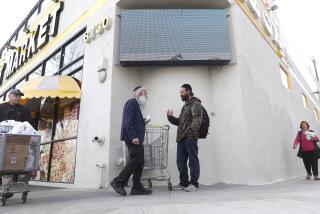Lankershim Impressed by Grazing Land
- Share via
In early 1869, a Jewish immigrant from Nuremburg, Bavaria, rode through what is now the San Fernando Valley on his way to inspect his various farms and ranches in Southern California. He liked what he saw.
Isaac Lankershim, a successful grain grower and stockman, was impressed by the Valley’s high wild oats, which he thought ideal for grazing. Later that year, he heard about the money troubles of Pio Pico, the last Mexican governor of California who also owned much of the Valley. Lankershim joined several other prominent Northern California businessmen to create the San Fernando Farm Assn., later renamed the Los Angeles Farm & Milling Co.
Pico sold most of his land to the association for $115,000, and by late 1869, Lankershim’s group owned 60,000 acres that included what we now call Van Nuys, Sherman Oaks, Reseda, Encino, Tarzana, Universal City and Woodland Hills. The northern border of that land today is Roscoe Boulevard. North Hollywood was originally called Lankershim, until residents changed the name in 1927, hoping to lure lucrative studios.
In 1871, Lankershim’s son, James Boon Lankershim, moved south to supervise the ranch, where the association had started raising sheep. That enterprise fared badly, and by 1875, a two-year drought had wiped out 40,000 sheep. Meanwhile, the wheat crop was more productive than anyone had expected.
Lankershim’s company built the Valley’s first flour mill and produced a record 510,000 bushels by 1888. During this time, Lankershim cut narrow roads through the high wheat fields; one of these roads became Lankershim Boulevard.
As economic pressures mounted, J.B. Lankershim subdivided much of the land in 5-, 10-, 20- and 40-acre parcels, which he sold for $120 an acre. The Lankershims continued to live on what became the Lankershim Ranch until the last of the Lankershims died in 1948. Their remaining property was subdivided in the early 1950s.
More to Read
Sign up for Essential California
The most important California stories and recommendations in your inbox every morning.
You may occasionally receive promotional content from the Los Angeles Times.










